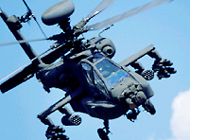
If you bought a brand-new pickup truck, only to find out that it could either drive on the highway or carry cargo, but not both, you wouldn’t be a happy customer. Yet the Pentagon is in a similar situation with the AH-64D Apache Longbow, a new attack helicopter from Boeing, and it appears to be satisfied — it plans on spending $4.9 billion to buy 758 of them.
According to a little-noticed General Accounting Office (GAO) report released in September, the Longbow lacks the “agility to operate successfully in combat.” At issue is the helicopter’s “vertical rate of climb” (VROC), a crucial measure of maneuverability. The Army required the Longbow to have a VROC of 450 feet per minute at an altitude of 4,000 feet and a temperature of 95 degrees, and the helicopter can indeed pass that test. But when loaded with fuel and a full complement of 12 missiles — an additional 1,721 pounds — the Longbow falls short of that goal. Literally.
Do the math: When not fully loaded, the Longbow’s VROC is an impressive 895 feet per minute. Army engineers say that for every pound the Longbow gains, the helicopter loses .839 feet per minute of lift. Multiply .839 by the additional weight of missiles and fuel, subtract that number from the unloaded Longbow’s VROC, and the result is negative 549 feet per minute. In other words, the Longbow would, in theory, not only be unable to climb, it wouldn’t be able to maintain altitude — even at maximum power.
While a fully loaded Longbow can definitely fly, the negative VROC would, in the words of the GAO report, “decrease the helicopter’s ability to evade enemy fire, thereby decreasing survivability.”
In its response to the report, the Pentagon claimed the GAO “incorrectly combined requirements.” It agrees that the Longbow must have a VROC of 450 feet per minute, and that it has to carry 12 missiles. It just doesn’t think it has to do both at the same time.
“That’s ludicrous,” says one GAO analyst. “The Joint Requirements Oversight Council [the Pentagon agency charged with overseeing requirements for major weapons programs] confirmed that the helicopter had to meet VROC requirements while carrying 12 missiles.” According to the GAO, the Longbow is only supposed to be able to do one thing at all times: kill the enemy. In order to do that, it needs to be both maneuverable and carry as many missiles as possible. (When contacted by Mother Jones, Army officials referred us to the Pentagon’s response to the GAO.)
The Longbow isn’t the first case in which the Pentagon has dumbed down requirements for a major weapons program. The practice is so common that critics have given the elastic requirements a name: “rubber baselines.” When a weapons program doesn’t meet one of its goals, the Pentagon simply redesigns the goal. Taxpayers end up paying the same amount, or more, for a weapon that does less.
Chuck Spinney, a Pentagon analyst, points to the C-17, a new Air Force transport plane, as a classic example of a rubber baseline. Because the C-17 is overweight, the Pentagon lowered its range and payload requirements — crucial performance parameters for the plane — three times.
Local inspectors rejected the C-17, confirms Ernie Fitzgerald, another Pentagon analyst, “but an Air Force inspection team came out and overruled them. That plane never met its original specs and it never will.”
Some officials, both inside the Pentagon and out, suggest there’s nothing surprising about weapons development programs failing to meet their original requirements. The problem, they say, is that goals are set too high in the first place. Often, it’s a result of contractors wanting to impress the Pentagon, which in turn wants to impress Congress.
Contractors look to “turn on the cash flow,” says Spinney, “and then lock the spigot open.” They rush weapons into production without adequate testing, and by the time they find problems, “[the Pentagon has] too much invested to change anything. So they just dumb down the requirements.”
“There are only two phases to these programs,” says Fitzgerald. “Too early to tell. And too late to stop.”















